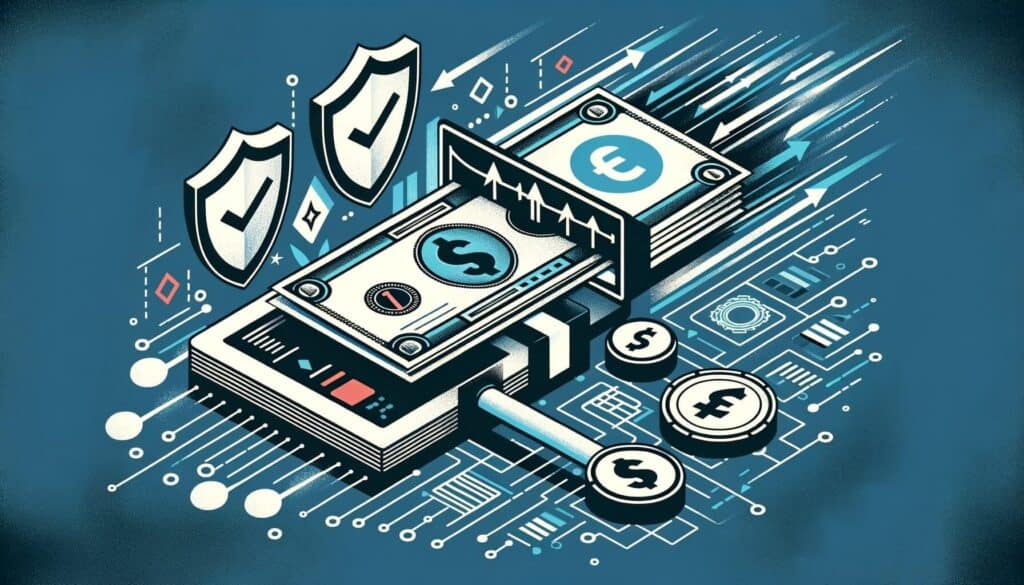
By American April 3, 2025
In today’s digital age, electronic funds transfer (EFT) payments have become an integral part of our daily lives. Whether you’re paying bills, making online purchases, or receiving your salary, chances are you’ve used EFT payments without even realizing it. But what exactly is an EFT payment, and how does it work? In this comprehensive guide, we will delve into the world of EFT payments, exploring its various types, benefits, security measures, and more.
electronic funds transfer (EFT) payments, also known as electronic funds transfers, refer to the process of transferring money electronically from one bank account to another. This method eliminates the need for physical checks or cash, making transactions faster, more convenient, and secure. EFT payments can be used for a wide range of purposes, including paying bills, making online purchases, transferring funds between accounts, and receiving payments from clients or employers.
How EFT Payments Work: A Step-by-Step Guide
To understand how electronic funds transfer (EFT) payments work, let’s walk through a step-by-step guide:
Step 1: Initiation – The sender initiates the EFT payment by providing the necessary information, such as the recipient’s bank account number, routing number, and the amount to be transferred. This information can be entered manually or saved in the sender’s online banking system for future use.
Step 2: Authorization – Once the payment details are entered, the sender authorizes the transfer by providing their own authentication, such as a password, PIN, or biometric verification. This step ensures that only authorized individuals can initiate EFT payments.
Step 3: Verification – The sender’s bank verifies the availability of funds in the sender’s account to ensure that the payment can be processed. If the funds are insufficient, the payment may be declined or put on hold until sufficient funds are available.
Step 4: Transmission – After verification, the sender’s bank electronically transmits the payment instructions to the recipient’s bank through a secure network, such as the Automated Clearing House (ACH) system. This transmission includes the payment details, such as the amount, recipient’s account information, and any additional instructions.
Step 5: Processing – Upon receiving the payment instructions, the recipient’s bank processes the transaction by debiting the sender’s account and crediting the recipient’s account with the transferred amount. This process typically takes a few business days, although some electronic funds transfer (EFT) payments can be processed in real-time.
Step 6: Confirmation – Once the payment is processed, both the sender and recipient receive confirmation of the transaction. This confirmation can be in the form of an email, SMS, or a notification within their online banking system.
Types of EFT Payments: Exploring Different Methods
There are several types of EFT payments, each catering to different needs and preferences. Let’s explore some of the most common methods:
1. Direct Deposit: Direct deposit is a popular method used by employers to pay their employees’ salaries. Instead of issuing physical checks, the employer transfers the funds directly into the employees’ bank accounts. This method saves time and eliminates the risk of lost or stolen checks.
2. Online Bill Payments: Many individuals and businesses use EFT payments to pay their bills online. Whether it’s utility bills, credit card payments, or mortgage installments, online bill payments offer convenience and flexibility. Users can schedule recurring payments or make one-time payments, reducing the hassle of writing and mailing checks.
3. Wire Transfers: Wire transfers are a fast and secure method of transferring funds between banks or financial institutions. This method is commonly used for large transactions, such as purchasing real estate or transferring funds internationally. Wire transfers are typically processed in real-time, ensuring quick access to the transferred funds.
4. Peer-to-Peer Payments: Peer-to-peer (P2P) payment platforms, such as Venmo, PayPal, and Zelle, have gained popularity in recent years. These platforms allow individuals to send and receive money directly from their bank accounts or linked credit cards. P2P payments are often used for splitting bills, reimbursing friends, or making online purchases.
Benefits of EFT Payments: Why Businesses and Individuals Choose Electronic Funds Transfer
EFT payments offer numerous benefits for both businesses and individuals. Let’s explore some of the key advantages:
1. Convenience: EFT payments eliminate the need for physical checks, cash, or visits to the bank. With just a few clicks, users can initiate payments from the comfort of their homes or offices. This convenience saves time and effort, allowing individuals and businesses to focus on more important tasks.
2. Speed: Unlike traditional payment methods, such as mailing checks or waiting for funds to clear, EFT payments are processed quickly. Depending on the type of EFT payment, funds can be transferred within minutes or a few business days. This speed is particularly beneficial for urgent payments or time-sensitive transactions.
3. Cost Savings: EFT payments can significantly reduce costs for businesses and individuals. With no need for paper checks, envelopes, stamps, or manual processing, businesses can save on printing and mailing expenses. Individuals can also save on check-cashing fees or money transfer charges, especially for international transactions.
4. Security: EFT payments offer enhanced security compared to physical checks or cash. Transactions are encrypted and transmitted through secure networks, reducing the risk of fraud or theft. Additionally, EFT payments leave a digital trail, making it easier to track and reconcile transactions.
5. Accessibility: EFT payments provide accessibility to individuals who may not have access to traditional banking services. With a bank account and an internet connection, users can send and receive funds from anywhere in the world. This accessibility promotes financial inclusion and empowers individuals to participate in the digital economy.
Setting Up EFT Payments: A Comprehensive Guide for Businesses
For businesses, setting up EFT payments involves a few essential steps. Let’s explore a comprehensive guide to help businesses get started:
Step 1: Choose a Payment Processor – Businesses need to select a payment processor or a merchant account provider that offers EFT payment services. It’s important to research and compare different providers to find the one that best suits the business’s needs in terms of fees, features, and customer support.
Step 2: Gather Required Information – To set up EFT payments, businesses need to gather certain information, such as their bank account details, tax identification number, and business registration documents. This information is typically required by the payment processor to verify the business’s legitimacy and comply with regulatory requirements.
Step 3: Complete the Application Process – Once the necessary information is gathered, businesses can proceed with the application process. This usually involves filling out an online application form provided by the payment processor. The form may require details about the business, its owners, and financial information.
Step 4: Undergo Verification and Approval – After submitting the application, the payment processor will review the information provided and may request additional documentation or clarification. This verification process ensures that the business meets the necessary requirements and complies with anti-money laundering (AML) and know your customer (KYC) regulations. Once approved, the business can start accepting EFT payments.
Step 5: Integrate Payment Gateway – To accept EFT payments online, businesses need to integrate a payment gateway into their website or e-commerce platform. The payment gateway acts as a secure bridge between the business’s website and the payment processor, facilitating the transfer of payment information.
Step 6: Test and Launch – Before going live, businesses should thoroughly test their EFT payment system to ensure its functionality and compatibility with their website or platform. This testing phase helps identify and resolve any issues or bugs. Once the system is deemed ready, businesses can launch their EFT payment option and start accepting payments from customers.
Security Measures in EFT Payments: Ensuring Safe and Secure Transactions
Security is a top priority when it comes to EFT payments. To ensure safe and secure transactions, various measures are implemented. Let’s explore some of the key security measures:
1. Encryption: EFT payments use encryption technology to protect sensitive information during transmission. Encryption converts the payment data into a coded format that can only be deciphered by authorized parties. This ensures that even if intercepted, the data remains unreadable and secure.
2. Secure Socket Layer (SSL) Certificates: SSL certificates are used to establish a secure connection between the sender’s device and the recipient’s server. This certificate encrypts the data exchanged between the two parties, preventing unauthorized access or tampering.
3. Two-Factor Authentication (2FA): Two-factor authentication adds an extra layer of security to EFT payments. In addition to a password or PIN, users are required to provide a second form of authentication, such as a unique code sent to their mobile device or a biometric verification, like a fingerprint or facial recognition.
4. Tokenization: Tokenization is a process that replaces sensitive payment data, such as credit card numbers or bank account details, with a unique identifier called a token. This token is used for transaction processing, while the actual payment data is securely stored in a separate system. Tokenization reduces the risk of data breaches and minimizes the impact of a potential breach.
5. Fraud Detection and Prevention: Payment processors employ advanced fraud detection and prevention systems to identify and mitigate fraudulent activities. These systems analyze transaction patterns, user behavior, and other data points to detect suspicious activities and flag potential fraud. In case of suspicious transactions, additional verification steps may be required to ensure the legitimacy of the payment.
Common Challenges in EFT Payments: Troubleshooting and Solutions
While EFT payments offer numerous benefits, they can also present certain challenges. Let’s explore some common challenges and their solutions:
1. Payment Rejections: EFT payments can be rejected for various reasons, such as insufficient funds, incorrect account information, or technical issues. To resolve payment rejections, users should ensure they have sufficient funds in their account, double-check the recipient’s account details, and contact their bank or payment processor for assistance.
2. Transaction Delays: EFT payments may sometimes experience delays due to factors like bank processing times, weekends, or public holidays. To avoid transaction delays, users should schedule payments in advance, especially for time-sensitive transactions. It’s also advisable to check the recipient’s bank’s processing times to ensure timely delivery.
3. Disputes and Chargebacks: In some cases, disputes or chargebacks may arise in EFT payments. This can occur when a customer disputes a transaction, claiming it was unauthorized or fraudulent. To handle disputes and chargebacks, businesses should maintain proper documentation, provide clear refund policies, and promptly respond to customer inquiries. It’s also important to work closely with the payment processor to resolve any disputes efficiently.
4. Technical Glitches: Like any digital system, EFT payments can occasionally experience technical glitches or system failures. To address technical issues, users should ensure they are using the latest version of their banking or payment app, clear cache and cookies, and contact their bank or payment processor for technical support.
EFT Payment Regulations and Compliance: Understanding the Legal Framework
EFT payments are subject to various regulations and compliance requirements to ensure transparency, security, and consumer protection. Let’s explore the legal framework surrounding EFT payments:
1. Anti-Money Laundering (AML) Regulations: AML regulations aim to prevent money laundering and the financing of illegal activities. Financial institutions and payment processors are required to implement robust AML measures, such as customer due diligence, transaction monitoring, and reporting suspicious activities to the relevant authorities.
2. Know Your Customer (KYC) Requirements: KYC requirements mandate that financial institutions and payment processors verify the identity of their customers to prevent fraud and identity theft. This involves collecting and verifying customer information, such as identification documents, proof of address, and business registration documents for corporate customers.
3. Payment Card Industry Data Security Standard (PCI DSS): PCI DSS is a set of security standards established by major credit card companies to protect cardholder data. Businesses that accept credit card payments, including EFT payments, must comply with PCI DSS requirements to ensure the secure handling of cardholder information.
4. Consumer Protection Laws: Consumer protection laws govern EFT payments to safeguard consumers’ rights and interests. These laws ensure transparency in transaction fees, protect against unauthorized transactions, and provide mechanisms for dispute resolution. Businesses must comply with these laws to maintain consumer trust and avoid legal consequences.
Frequently Asked Questions (FAQs) about EFT Payments: Clearing Doubts and Misconceptions
Q1. What is the difference between EFT and ACH payments?
Answer: EFT payments refer to the broader concept of electronically transferring funds between bank accounts, while Automated Clearing House (ACH) payments are a specific type of EFT payment that uses the ACH network for processing. ACH payments are commonly used for direct deposits, online bill payments, and other recurring transactions.
Q2. Are EFT payments secure?
Answer: Yes, EFT payments are generally secure. They employ encryption, secure networks, and authentication measures to protect sensitive information and prevent unauthorized access. However, users should also take precautions, such as using strong passwords, keeping their devices and software up to date, and avoiding suspicious links or emails.
Q3. Can EFT payments be reversed?
Answer: EFT payments can be reversed in certain circumstances. For example, if a payment was made in error or without authorization, the sender can request a reversal or refund from their bank or payment processor. However, once a payment is processed and funds are transferred, reversing the payment may require the recipient’s consent or involve a dispute resolution process.
Q4. Are there any transaction limits for EFT payments?
Answer: Transaction limits for EFT payments vary depending on the user’s bank, payment processor, and the type of transaction. Some banks or payment processors may impose daily or monthly limits to prevent fraud or unauthorized transactions. Users should check with their bank or payment processor for specific transaction limits.
Q5. Can EFT payments be made internationally?
Answer: Yes, EFT payments can be made internationally. However, the availability and cost of international EFT payments may vary depending on the sender’s and recipient’s countries, currency exchange rates, and any applicable fees or restrictions imposed by banks or payment processors. It’s advisable to check with the respective financial institutions for international EFT payment options.
Conclusion
Electronic funds transfer (EFT) payments have revolutionized the way we transfer funds, offering convenience, speed, and security. Understanding the basics, how EFT payments work, the different types available, their benefits, setting up EFT payments for businesses, security measures, common challenges, and regulatory compliance is crucial for individuals and businesses alike. By embracing electronic funds transfer (EFT) payments, we can streamline financial transactions, enhance efficiency, and adapt to the evolving digital landscape.




